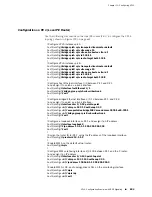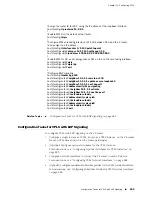
requirements and procedures for subscriber policies are the same whether you
employ BGP or LDP signaling for VPLS.
Network Interface Types
VPLS instances, like bridge groups, support two types of network interfaces:
■
Subscriber (client)—A subscriber (client) interface is downstream from the traffic
flow; that is, the traffic flow direction is from the server (trunk) to the client
(subscriber). This is the default network interface type for both VPLS instances
and bridge groups.
■
Trunk (server)—A trunk (server) interface is upstream from the traffic flow; that
is, the traffic flow direction is from the client (subscriber) to the server (trunk).
To configure a trunk interface, you must specify the
subscriber-trunk
keyword
as part of the
bridge-group
command. The VPLS virtual core interface always
acts as a trunk interface, and cannot be configured as a subscriber interface.
Default Subscriber Policies
Each network interface is associated with a default subscriber policy for that interface
type. The subscriber policy is a set of forwarding and filtering rules that defines how
the specified interface handles various packet or attribute types, as follows:
■
For each packet type listed in Table 79 on page 596, the subscriber policy specifies
whether the network interface permits (forwards) or denies (filters or drops)
packets of that type.
■
For the relearn attribute, the subscriber policy specifies whether the network
interface can relearn a MAC address entry on a different interface from the one
initially associated with this entry in the forwarding table. Permit indicates that
relearning is allowed; deny indicates that relearning is prohibited.
Table 79 on page 596 lists the default values for each packet or attribute type defined
in the policies for subscriber interfaces and trunk interfaces. The default subscriber
policy differs in one way from the default trunk policy: broadcast packets and packets
with unknown unicast destination addresses (DAs) are denied in the subscriber policy
and permitted in the trunk policy.
Table 79: Default Subscriber Policies for VPLS Network Interfaces
Default Trunk Policy
Default Subscriber Policy
Packet/Attribute Type
Permit
Permit
ARP
Permit
Deny
Broadcast
Permit
Permit
IP
Permit
Permit
MPLS
Permit
Permit
Multicast
Permit
Permit
PPPoE
596
■
Configuring Subscriber Policies for VPLS Network Interfaces
JUNOSe 11.1.x BGP and MPLS Configuration Guide
Summary of Contents for BGP
Page 6: ...vi ...
Page 8: ...viii JUNOSe 11 1 x BGP and MPLS Configuration Guide ...
Page 37: ...Part 1 Border Gateway Protocol Configuring BGP Routing on page 3 Border Gateway Protocol 1 ...
Page 38: ...2 Border Gateway Protocol JUNOSe 11 1 x BGP and MPLS Configuration Guide ...
Page 234: ...198 Monitoring BGP JUNOSe 11 1 x BGP and MPLS Configuration Guide ...
Page 236: ...200 Multiprotocol Layer Switching JUNOSe 11 1 x BGP and MPLS Configuration Guide ...
Page 542: ...506 Monitoring BGP MPLS VPNs JUNOSe 11 1 x BGP and MPLS Configuration Guide ...
Page 544: ...508 Layer 2 Services Over MPLS JUNOSe 11 1 x BGP and MPLS Configuration Guide ...
Page 610: ...574 Virtual Private LAN Service JUNOSe 11 1 x BGP and MPLS Configuration Guide ...
Page 624: ...588 VPLS References JUNOSe 11 1 x BGP and MPLS Configuration Guide ...
Page 680: ...644 Virtual Private Wire Service JUNOSe 11 1 x BGP and MPLS Configuration Guide ...
Page 724: ...688 Monitoring MPLS Forwarding Table for VPWS JUNOSe 11 1 x BGP and MPLS Configuration Guide ...
Page 725: ...Part 6 Index Index on page 691 Index 689 ...
Page 726: ...690 Index JUNOSe 11 1 x BGP and MPLS Configuration Guide ...
















































